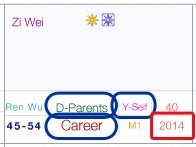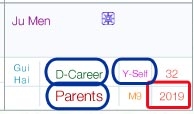In a normal work environment, ceteris paribus*, everyone should have the opportunity to be promoted. If you miss out on a promotion in one cycle, you would typically expect to be considered in a future review cycle. This assumption is generally accepted, and if you continue to miss out on promotions after several cycles, particularly if others in your team have been promoted multiple times, it may suggest that you are being deliberately overlooked for some reason.
The purpose of this article is to introduce you to some basic techniques of Zi Wei Dou Shu (ZWDS), which can be used to predict when this event might occur for you. This is not an exhaustive list, as there are many other ZWDS techniques that require more advanced training to interpret.
For beginners, the easiest way to interpret a chart is to use the Local Sihua technique, which can be applied to determine the timing of a job promotion.
| Local Sihua | Symbol on the chart |
|---|---|
| Self Hua Lu (自化祿) | |
| Self Hua Quan (自化权) | |
| Inherited Hua Lu (生年化祿) | |
| Inherited Hua Quan (生年化权) |
To plot a free ZWDS Sihua Flying Stars chart, refer Sihua Flying Stars chart
For more extra ZWDS learning, refer ZWDS Sihua Flying Stars interpretation
For terminology pronunciation, refer ZWDS terminology
The purpose of Local Sihua is to activate interpretation for an event. To read a job recognition event, you need to locate where your Career cell (官禄宫) is activated using any of the above Local Sihua methods, along with a recognition line such as the Fame line (光明线) or Achievement line (成就线), to indicate that your career is starting to shine.
If your Career cell is activated without a Fame or Achievement line, it can still be interpreted, but for other subject matters rather than job recognition. If you can identify similar scenarios in your chart, then it suggests that your job promotion is already on the horizon, and all you need to do is determine when it will happen.
Some of the possible activation scenarios that commonly associated with the job promotion:
- D-Parents overstacks with Career and Y-Self (Refer Client 1 below for how it works on a chart and the “when”)
- D-Career overstacks with Parents and Y-Self (Refer Client 2 below for how it works on a chart and the “when”)
- D-Friends overstacks with Career and Y-Self
- D-Career overstacks with Friends and Y-Self
- D-Parents overstacks with Career and Y-Self
- D-Career overstacks with Parents and Y-Self
The first 2 scenarios mentioned above are illustrated with chart examples below. Hopefully, this will help you relate the scenarios better visually and understand the likelihood of when the job recognition is likely to happen.


However, it’s important to note that not all job recognitions result in a promotion. Rewards can come in different forms, such as monetary compensation, rank adjustments, location changes, contract extensions with the status quo, or even a lateral reshuffle with a more promising prospect.
Additionally, the Career cell doesn’t just represent work matters but can also represent study matters. If you’re planning to start studying outside of work hours, this could complicate how you interpret what your Career cell should represent.
Once you have a good grasp of Local Sihua techniques, you can proceed to explore other sihua techniques and subject matters in your Ziwei chart.
*Of course, there are many other factors that may influence such as other compensation in-lieu of promotion, rank seniority, budget constraints, education qualification, nature of the work, complexity of the organisation, promotion on discretionary basis, discriminative work practices etc — These are not the purpose of this article
